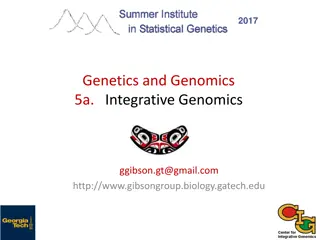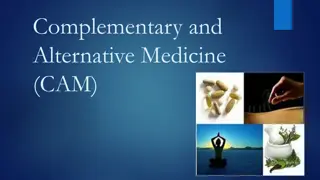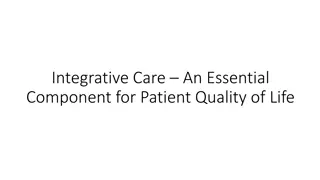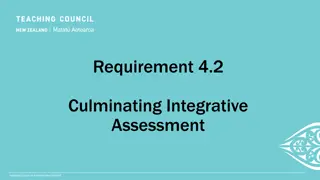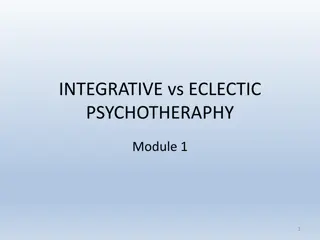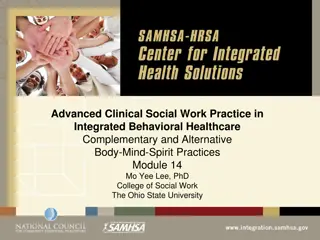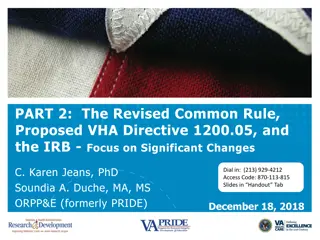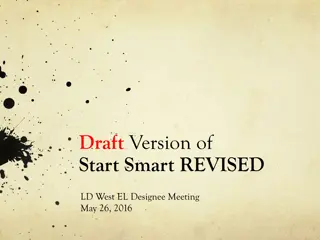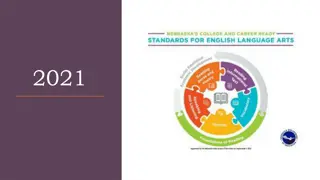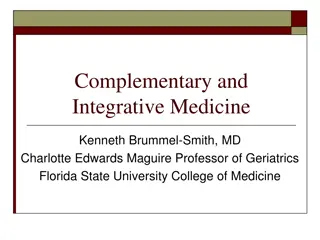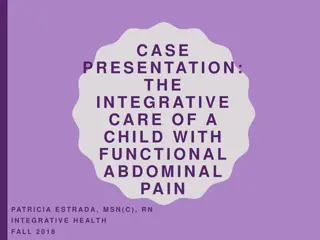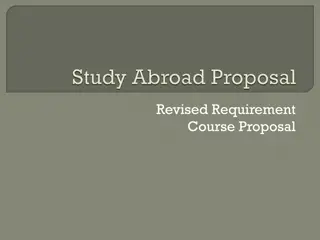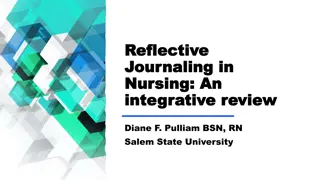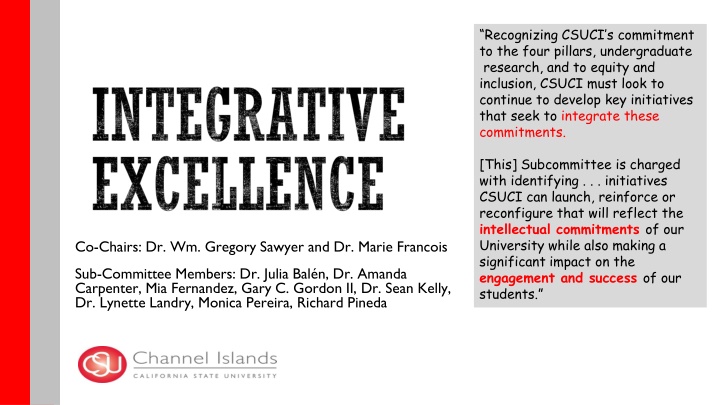
Key Initiatives for Integrating Commitment to Undergraduate Research and Equity at CSUCI
Discover the strategic proposals generated by a dedicated CSUCI subcommittee to enhance undergraduate research, equity, and inclusion at the university. Initiatives include expanding learning communities, institutionalizing student research programs, peer-to-peer collaborations, and faculty success programs. These initiatives aim to elevate student engagement and success while embodying CSUCI's core values.
Download Presentation

Please find below an Image/Link to download the presentation.
The content on the website is provided AS IS for your information and personal use only. It may not be sold, licensed, or shared on other websites without obtaining consent from the author. If you encounter any issues during the download, it is possible that the publisher has removed the file from their server.
You are allowed to download the files provided on this website for personal or commercial use, subject to the condition that they are used lawfully. All files are the property of their respective owners.
The content on the website is provided AS IS for your information and personal use only. It may not be sold, licensed, or shared on other websites without obtaining consent from the author.
E N D
Presentation Transcript
Recognizing CSUCIs commitment to the four pillars, undergraduate research, and to equity and inclusion, CSUCI must look to continue to develop key initiatives that seek to integrate these commitments. [This] Subcommittee is charged with identifying . . . initiatives CSUCI can launch, reinforce or reconfigure that will reflect the intellectual commitments of our University while also making a significant impact on the engagement and success of our students. Co-Chairs: Dr. Wm. Gregory Sawyer and Dr. Marie Francois Sub-Committee Members: Dr. Julia Bal n, Dr. Amanda Carpenter, Mia Fernandez, Gary C. Gordon II, Dr. Sean Kelly, Dr. Lynette Landry, Monica Pereira, Richard Pineda
Strategic Proposals Expanding Learning Communities Institutionalizing Student Research Peer-to-Peer Program Collaborations Faculty Success Programs Annual Campus Theme Programming 15 to Finish Early Intervention Integrated Career/Academic Advising Other Synergies: Stand Alone or Woven In
Expand Learning Communities Run by Undergraduate Studies bridging with Student Affairs (creating a new infrastructure) Under the Mission Centers and within Major Clusters Faculty development opportunities and RTP connections to incentivize faculty participation and foster cross-course collaboration. Each Center has an academic advisor and Student Affairs partner associated with their Learning Communities Groups chosen by Centers funded to attend Washington Center trainings for three years Some LCs paired with Math/Quantitative Reasoning courses to foster learning math in context Some LCs/LLCs target students yet to decide on a major First Year Community Coordinator Learning and Living-Learning Communities Embedded peer mentors Partners: Enrollment Management, Student Affairs, University Advancement, Technology and Innovation, Business and Financial Affairs
Expand Learning Communities (cont.) Forging partnerships with Divisions of Student Affairs, University Advancement, Technology and Innovation, Business and Financial Affairs and Academic Affairs in order to ensure quality and promote institutionalization Student Affairs builds orientation materials, events and activities around LC/LLCs while supporting LC/LLC co-curricular and extracurricular programming University Advancement (Foundation) partners develop familiarity with learning communities to promote them to donors University Advancement (Communication and Marketing) develop familiarity with learning communities and identify opportunities to promote LCs and their activities Student Affairs (Career Development Services) will work with Learning Communities for career exploration and internships related to LC themes Orient scholarships to match with learning communities
Institutionalize Student Research Create a Center for Student Research Invest permanent funding for existing Student Research initiatives, including support for student travel to conferences Preserve and institutionalize the Summer SURF faculty-mentored student research program Add an advisor to promote major scholarship opportunities (e.g., CSU Doctoral, Goldwater, Truman, etc.) and help prepare students to apply for these opportunities Coordination among Capstone and Major Research Classes across schools
Institutionalize Student Research (cont.) More support for annual SAGE Conference Work with the Writing Center to prepare students for conferences Work with the Library to create a Digital Scholarship Lab Work collaboratively and concert with the Divisions of Student Affairs, University Advancement, Business and Financial Affairs, Technology And Innovation and Academic Affairs
PEER-to-peer Programs Collaborations Building synergy in training, collaboration and assessment among different peer-to-peer programs across Divisions: PEEPs Tutors EOP and SSS Academic Advising Wellness Promotion Education Resident Assistants Orientation Leaders Career Development Center etc. Establish student assistant training resources group (i.e. learning outcomes, best practices, consistency in training experiences) Monthly meetings Integration of UNIV 399 Peer-to- Peer Effectiveness class Peers shadow experienced peers Better marketing for peer-to-peer programs
Faculty Success Programs Workshop series on active learning, best practices to reach first-gen students, managing difficult conversations Workshops offered through Mission-Based Centers and Student Research Center on best practices for infusing mission perspectives and research into courses Workshops offered by Student Affairs departments on student development, undocumented students, students with disabilities, students of concern Coordination with HR for Professional Development workshops Coordination with Teaching and Learning Innovations for on-line teaching best practices Training for chairs/observers/evaluators of faculty teaching on holistic evaluations Opportunities to develop individual research and creative activities agendas: writing groups, works-in-progress forums, proposal writing workshops with RSP, more campus funding for research and creative activities
Annual Campus Theme Programming Wicked Problem (inequality, homelessness, climate change, injustice, poverty) or something positive (inclusion, peace, community) Units/groups/classes engage theme throughout the semester: Mission-aligned Learning Communities and Living Learning Communities Housing and Residential Education (HRE) Student Research Mission Centers Multicultural Dream Center Associated Student Inc. Inclusive Student Services Career and Leadership Capstone courses Commuter programming Campus Reading Celebration
Early Intervention Career/Academic Advising Inter-divisional project to work with students, faculty, and staff to identify and pursue opportunities to improve aspects of student advising that relate to career advising, collaboration between Career Development Services, Academic Advising, and Center for Community Engagement Undeclared and pre-nursing students have high drop out rates (> 40%): early connection to academic and career advising and experiential learning opportunities Students explore relationships to and differences between major and career Internships key benchmarking indicator of career preparation: Advisors and Career Counselors work together to integrate internships early into academic planning
15 to Finish Create a holistic communication plan to encourage on-time graduation by investing in a university messaging campaign that urges students to take a full load of classes (15 units) every semester. Some CI students operate under the mistaken belief that 12 units is full time (true for financial aid, but bad for their pocketbook). For instance: Four year cost at 15 units per semester: 6802 x 4 = 27,208 Four year cost at 12 units per semester: 6802 x 5 = 34,010 15 to Finish saves you almost $7,000 Challenge: how to promote this while recognizing that many student need to work for living expenses and to contribute to family income. More scholarships to make it possible More availability of courses needed, especially those to take in sequence.
Other Synergies: Stand Alone or Woven In Synergy among and support for the Affinity and Marginalized Student Stoling/Chord Celebrations Si Se Pudo, Black Student Stoling Ceremony, Lavender Lunch Chord Ceremony, Undoca Student Stoling Ceremony, etc., tying the event into the Mission Mission-Based Centers (MBCs) -- Increase interconnection among MBCs, sustained connections to both courses and student affairs programming and sufficient staffing embedded in other proposals General Education Theme Tracks (pending GE policy implementation): Mission Centers, in close consultation with Departments and Chairs, will design GE Tracks; Each track will have a dedicated academic advisor Tracks can be grafted onto LCs to create a minor or endorsement on completion
Other Synergies (cont): Stand Alone or Woven In Improve communication throughout campus -- about programs, activities and events regarding opportunities for faculty, students, and staff. Outcome synergy (while maintaining additional specific ones) between the curriculum and the co-curriculum Lacayo Internships drawing on GE outcomes and Program Internship outcomes ROI programming drawing on SLOs for multicultural courses Student Leadership assessment: Honor Societies, Student Government, Associated Students participation, Student Clubs, etc.

